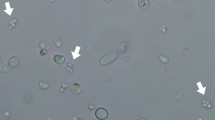Summary
DNA from the cultivated mushroom, Agaricus bisporus, was cloned into the bacteriophage lambda vector EMBL3 creating a partial genomic library. Ten random clones from the library were used to probe for restriction fragment length polymorphisms (RFLPs). Six of the ten probes detected polymorphisms and were used to demonstrate variation in wild and cultivated strains of the mushroom. These results suggest that RFLPs could form a basis for genetic finger-printing and subsequent strain protection in A. bisporus. In single spore progeny, RFLPs were used to demonstrate normal meiotic segregation and to differentiate between homokaryons and heterokaryons. RFLPs therefore have great potential in the development of the genetics and breeding of this commercially important species.
Similar content being viewed by others
References
Botstein D, White RL, Skolnick M, Davis RW (1980) Construction of a genetic linkage map in man using restriction fragment length polymorphisms. Am J Hum Genet 32:314–331
Cassidy JR, Moore D, Lu BJ, Pukkila PJ (1984) Unusual organisation and lack of recombination in the ribosomal genes of Coprinus cinereus. Curr Genet 8:607–613
Castle AJ, Horgen PA, Anderson JB (1987) Restriction fragment length polymorphisms in the mushrooms Agaricus brunnescens and Agaricus bitorquis. Appl Environ Microbiol 53:816–822
Clarke L, Carbon J (1976) A colony bank containing synthetic Col EI hybrid plasmids representative of the entire E. coli genome. Cell 9:91–99
Elliott TJ (1972) Sex and the single spore. Mushroom Sci 8:11–18
Elliott TJ (1985) The genetics and breeding of species of Agaricus. In: Flegg PB, Spencer DM, Wood DA (eds) The Biology and technology of the cultivated mushroom. Wiley, London, pp 111–139
Evans HJ (1959) Nuclear behaviour in the cultivated mushroom. Cromosoma 10:115–135
Frischauf AM, Lehrach H, Poutska A, Murray N (1983) Lambda replacement vectors carrying polylinker sequences. J Mol Biol 170:827–842
Fritsche G (1978) Breeding work. In: Chang ST, Hayes WA (eds) The Biology and cultivation of edible mushrooms. Academic Press, New York, pp 239–250
Fritsche G (1984) Breeding Agaricus bisporus at the mushroom experimental station, Horst. Mushroom J 122:49–55
Hintz WE, Mohan M, Anderson JB, Horgen PA (1985) The mitochondrial DNAs of Agaricus: heterogeneity in A. bitorquis and homogeneity in A. brunnescens. Curr Genet 9:127–132
Jeffreys AJ, Wilson V, Thein SL (1985) Hypervariable minisatellite regions in human DNA. Nature 314:67–73
Kligman AM (1950) Handbook of mushroom culture. Business Press, Lancaster/PA
Malloch D (1976) Agaricus brunnescens: the cultivated mushroom. Mycologia 68:910–919
Maniatis T, Fritsche EF, Sambrook J (1982) Molecular cloning — a laboratory manual. Cold Spring Harbor Laboratory Press, Cold Spring Harbor/NY
May B, Royse DJ (1982) Confirmation of crosses between lines of Agaricus brunnescens by isozyme analysis. Exp Mycol 6:238–292
Miller RE (1971) Evidence of sexuality in the cultivated mushroom Agaricus bisporus. Mycologia 63:630–634
Raeder U, Broda P (1986) Meiotic segregation analysis of restriction site polymorphisms allows rapid genetic mapping. EMBO J 5:1125–1127
Raper CA, Raper JR, Miller RE (1972) Genetic analysis of the life cycle of Agaricus bisporus. Mycologia 64:1088–1117
Rigby PWJ, Dieckmann M, Rhodes C, Berg P (1977) Labeling deoxyribonucleic acid to high specific activity in vitro by nick translation with DNA polymerase I. J Mol Biol 113:237–251
Royse DJ, May B (1982a) Use of isozyme variation to identify classes of Agaricus brunnescens. Mycologia 74:93–102
Royse DJ, May B (1982b) Genetic relatedness and its application in selective breeding of Agaricus brunnescens. Mycologia 74:569–575
Wu MJW, Cassidy JR, Pukkila PJ (1983) Polymorphisms in DNA of Coprinus cinereus. Curr Genet 7:385–392
Zolan ME, Pukkila PJ (1986). Inheritance of DNA methylation in Coprinus cinereus. Mol Cell Biol 6:195–200
Author information
Authors and Affiliations
Additional information
Communicated by G. Wenzel
Rights and permissions
About this article
Cite this article
Loftus, M.G., Moore, D. & Elliott, T.J. DNA polymorphisms in commercial and wild strains of the cultivated mushroom, Agaricus bisporus . Theoret. Appl. Genetics 76, 712–718 (1988). https://doi.org/10.1007/BF00303517
Received:
Accepted:
Issue Date:
DOI: https://doi.org/10.1007/BF00303517




